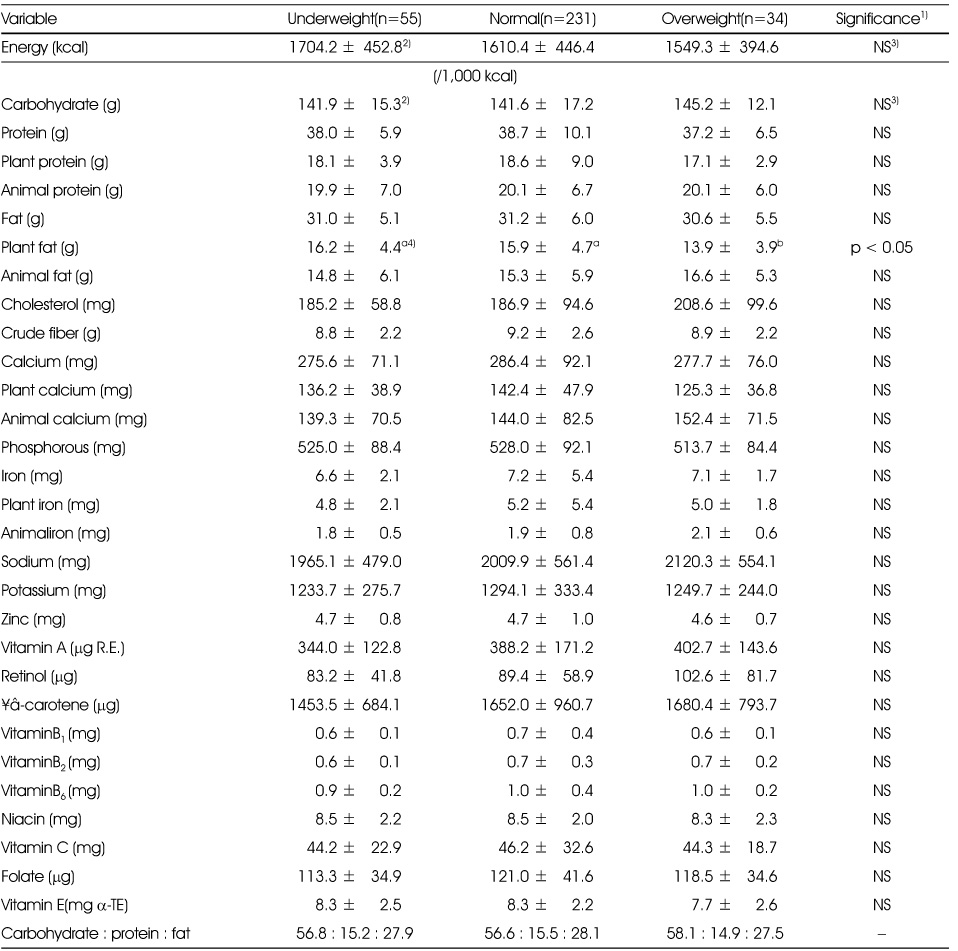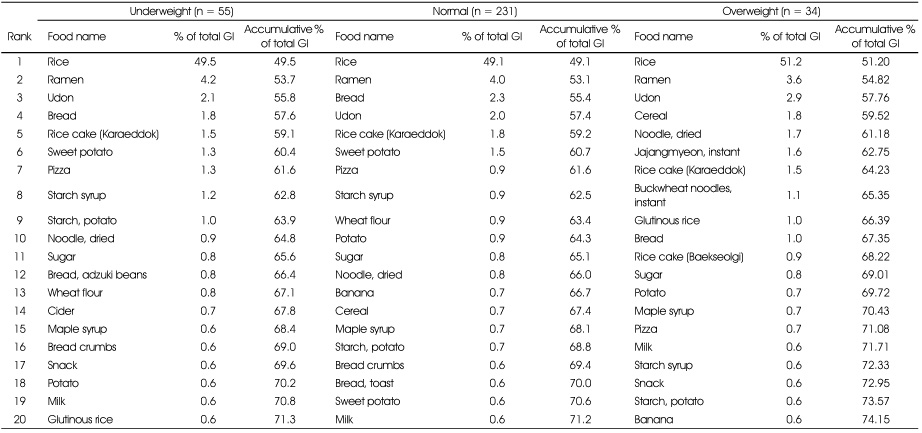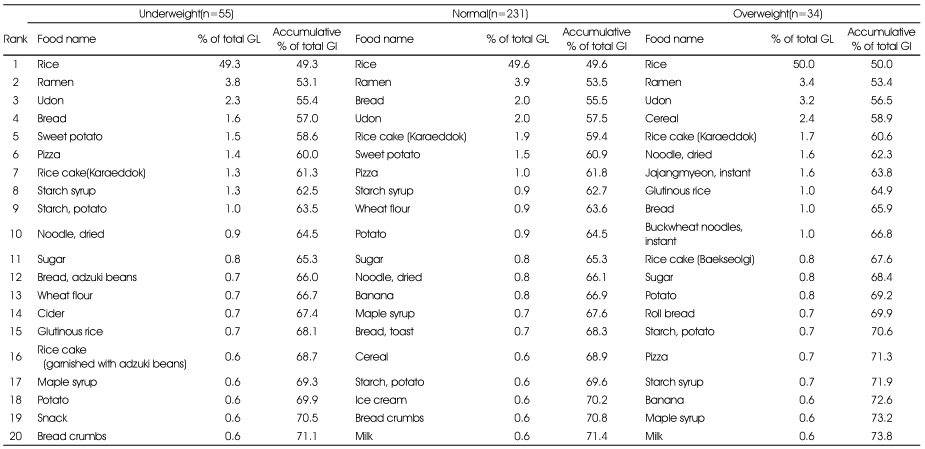Articles
- Page Path
- HOME > Korean J Community Nutr > Volume 17(4); 2012 > Article
-
Original Article
- A Study of Glycemic Index, Glycemic Load and Food Sources according to Body Mass Index in Female College Students
- Jee-Young Yeon, Eun-Young Kim
-
Korean Journal of Community Nutrition 2012;17(4):429-439.
DOI: https://doi.org/10.5720/kjcn.2012.17.4.429
Published online: August 31, 2012
Nutrition Policy Division, Nutrition Policy Office, Korea Food and Durg Administration, Osong, Korea.
1Department of Food and Nutrition, Sookmyung Women's University, Seoul, Korea.
- Corresponding author: Eun-Young Kim, Department of Food and Nutrition, Sookmyung Women's University, Cheongpa-dong 2(i)-ga, Yongsan-gu, Seoul 140-742, Korea. Tel: (02) 710-9465, Fax: (02) 701-2926, paperkey11@daum.net
Copyright © 2012 The Korean Society of Community Nutrition
- 317 Views
- 1 Download
- 1 Crossref
Abstract
- The purpose of this study was to evaluate nutrients intakes, glycemic index (GI), glycemic load (GL) according to body mass index (BMI) in female college students (n = 320). The study subjects were divided into 3 groups based on their body mass index, an underweight group (BMI < 18.5 kg/m2, n = 55), a normal group (18.5 kg/m2 ≤ BMI < 23 kg/m2, n = 231), and an overweight group (23 kg/m2 ≤ BMI < 25 kg/m2, n = 34). The food and nutrition intake data obtained by administering a 3-day food record and were analyzed by using Can pro 3.0 software. Anthropometric measurements were collected from each subject. Body weights and BMI of the underweight group were 45.9 kg, 17.6 kg/m2, those of the normal group were 53.8 kg, 20.5 kg/m2, and those of overweight group were 62.6 kg, 23.8 kg/m2, respectively. The mean daily dietary GI of underweight, normal and overweight groups was 66.2, 65.8 and 66.5, respectively. These differences were statistically non-significant. The mean daily dietary GL of underweight, normal and overweight groups were 159.2, 149.4, and 148.9, respectively. The major food source of dietary GI and GL was rice in the three groups. Dietary GI and GL were not significantly correlated with obesity when adjusted for energy, carbohydrate and dietary fiber intake.
- 1. Anderson GH, Catherine NL, Woodend DM, Wolever TM. Inverse association between the effect of carbohydrates on blood glucose and subsequent short-term food intake in young men. Am J Clin Nutr. 2002; 76(5): 1023-1030.ArticlePubMed
- 2. Bae YJ, Choi MK. A study of nutrient intakes, glycemic index, and glycemic load according to obesity index in elementary school students. J East Asian Soc Diet Life. 2011; 2(2): 174-184.
- 3. Barba G, Troiano E, Russo P, Venezia A, Siani A. Inverse association between body mass and frequency of milk consumption in children. Br J Nutr. 2005; 93(1): 15-19.ArticlePubMed
- 4. Burton S, Creyer EH, Kees J, Huggins K. Attacking the obesity epidemic: the potential health benefits of providing nutrition information in restaurants. Am J Public Health. 2006; 96(9): 1669-1675.ArticlePubMedPMC
- 5. Chai HJ, Hong H, Kim HS, Lee JS, Yu CH. Relationship between food intakes, glycemic index, glycemic load, and body weight among high school boys in Seoul. Korean J Nutr. 2008; 41(7): 645-657.
- 6. Cheng G, Karaolis-Danckert N, Libuda L, Bolzenius K, Remer T, Buyken AE. Relation of dietary glycemic index, glycemic load, and fiber and whole-grain intakes during puberty to the concurrent development of percent body fat and body mass index. Am J Epidemiol. 2009; 169(6): 667-677.ArticlePubMed
- 7. Choi MK, Bae YJ, Han EK, Sung CJ. Correlation between glycemic load and blood lipid profile in some Korean according to age. J East Asian Soc Diet Life. 2006; 16(1): 85-92.
- 8. Davis JN, Alexander KE, Ventura EE, Kelly LA, Lane CJ, Byrd-Williams CE, Toledo-Corral CM, Roberts CK, Spruijt-Metz D, Weigensberg MJ, Goran MI. Associations of dietary sugar and glycemic index with adiposity and insulin dynamics in overweight Latino youth. Am J Clin Nutr. 2007; 86(5): 1331-1338.ArticlePubMed
- 9. Deierlein AL, Siega-Riz AM, Herring A. Dietary energy density but not glycemic load is associated with gestational weight gain. Am J Clin Nutr. 2008; 88(3): 693-699.ArticlePubMed
- 10. Du H, Van der A DL, Feskens EJ. Dietary glycemic index: a review of the physiological mechanism and observed health impacts. Acta Cardiol. 2006; 61: 383-397.PubMed
- 11. Foster-Powell K, Holt SH, Brand-Miller JC. International table of glycemic index and glycemic load values. Am J Clin Nutr. 2002; 76(1): 5-56.PubMed
- 12. Gaesser GA. Carbohydrate quantity and quality in relation to body mass index. J Am Diet Assoc. 2007; 107(10): 1768-1780.PubMed
- 13. Hare-Bruun H, Flint A, Heitmann BL. Glycemic index and glycemic load in relation to changes in body weight, body fat distribution, and body composition in adult Danes. Am J Clin Nutr. 2006; 84(4): 871-879.
- 14. Higgins JA, Brand Miller JC, Denyer GS. Development of insulin resistance in the rat is dependent on the rate of glucose absorption from the diet. J Nutr. 1996; 126(3): 596-602.
- 15. Hong H, Lee JS. The relationship between food and nutrition intakes, glycemic index, glycemic load and body mass index among high school girls in school. Korean J Nutr. 2010; 43(5): 500-512.
- 16. Hui LL, Nelson EA. Meal glycemic load of normal-weight and overweight Hong Kong children. Eur J Clin Nutr. 2006; 60(2): 220-227.
- 17. Jenkins DJ, Wolver TM, Jenkins AL. Starchy foods and glycemic index. Diabetes Care. 1988; 11(2): 149-159.
- 18. Jenkins DJ, Kendall CW, Augustin LS, Franceschi S, Hamidi M, Marchie A, Jenkins AL, Axelsen M. Glycemic index: overview of implications in health and disease. Am J Clin Nutr. 2002; 76(1): 266S-273S.
- 19. Kabir M, Rizkalla SW, Quignard-Boulangé A, Guerre-Millo M, Boillot J, Ardouin B, Luo J, Slama G. A high glycemic index starch diet affects lipid storage-related enzymes in normal and to a lesser extent in diabetic rats. J Nutr. 1998; 128(11): 1878-1883.
- 20. Kim IJ. Glycemic index revisited. Korean Diabetes J. 2009; 33(4): 261-266.
- 21. Kim K, Yun SH, Choi BY, Kim MK. Cross-sectional relationship between dietary carbohydrate, glycemic index, glycemic load and risk of the metabolic syndrome in a Korean population. Br J Nutr. 2008; 100(3): 576-584.
- 22. Kim OH, Jung H, Kim JH. Comparison of food intake and serum lipid levels in overweight and obese women by body mass index. Korean J Community Nutr. 2007; 12(1): 40-49.
- 23. Korean Society for the Study of Obesity. Diagnosis and therapy of obesity: the Asia-Pacific area guideline. 2000; Seoul.
- 24. Lau C, Toft U, Tetens I, Richelsen B, Jorgensen T, Borch-Johnsen K, Clumer C. Association between dietary glycemic index, glycemic load, and body mass index in the Inter99 study :is under reporting a problem? Am J Clin Nutr. 2006; 84(3): 641-645.
- 25. Livesey G, Taylor R, Hulshof T, Howelett J. Glycemic response and health-a systemic review and meta-analysis: relations between dietary glycemic properties and health outcomes. Am J Clin Nutr. 2008; 87(1): 258S-268S.
- 26. Ludwig DS. Dietary glycemic index and obesity. J Nutr. 2000; 130: 2S Suppl. 280S-283S.
- 27. Ma YS, Olendzki B, Chiriboga D, hebert JR, Le YF, Li WJ, Campbell MJ, Gendreau K, Ockens IS. Association between dietary carbohydrates and body weight. Am J Epidemiol. 2005; 161(4): 359-367.
- 28. Mendez MA, Covas MI, Marrugat J, Vila J, Schröder H. Glycemic load, glycemic index, and body mass index in Spanish adults. Am J Clin Nutr. 2009; 89(1): 316-322.
- 29. Ministry of Health & Welfare. The third Korea National Health & Nutrition Examination Survey (KNHANES. IV), 2009-Nutrition Survey(I). 2010; Seoul: Ministry of Health & Welfare.
- 30. Murakami K, Sasaki S, Okubo H, Takahashi Y, Hosoi Y, Itabashi M. Dietary fiber intake, dietary glycemic index and load, and body mass index: a cross-sectional study of 3931 Japanese women aged 18-20 years. Eur J Clin Nutr. 2007; 61(8): 986-995.
- 31. Neo nutral glycemin index tested. cited 2011 March 8. Available from http://gitest.co.kr/.
- 32. Park JK, Yim MJ. A study on the nutritional status and body mass index in Korean college women. J Korean Soc Study Obes. 2003; 12: 24-29.
- 33. Raatz SK, Torkelson CJ, Redmon JB, Reck KP, Kwong CA, Swanson JE, Liu C, Thomas W, Bantle JP. Reduced glycemic index and glycemic load diets do not increase the effects of energy restriction on weight loss and insulin sensitivity in obese men and women. J Nutr. 2005; 135(10): 2387-2391.
- 34. Sahyoun NR, Anderson AL, Kanaya AM, Koh-Banerjee P, Kritchevsky SB, de Rekeneire N, Tylavsky FA, Schwartz AV, Lee JS, Harris TB. Dietary glycemic index and load, measures of glucose metabolism, and body fat distribution in older adults. Am J Clin Nutr. 2005; 82(3): 547-552.
- 35. Song S, Choi H, Lee S, Park JM, Kim BR, Paik HY, Song Y. Establishing a table of glycemic index values for common Korean foods and an evaluation of the dietary glycemic index among the Korean adult population. Korean J Nutr. 2012; 45(1): 80-93.
- 36. The Korean Nutrition Society. Can Pro 3.0 (nutritional analysis program). 2006.
- 37. The university of sydney, search for the glycemic index. cited 2011 March 12. Available from http://www.glycemicindex.com/.
- 38. Wolever TM. Dietary carbohydrates and insulin action in humans. Br J Nutr. 2000; 83: suppl 1. S97-S102.
- 39. Yu CH, Lee JS. A study on the nutritional status according to body mass index in Korean college women. Korean J Nutr. 2004; 37(10): 899-907.
- 40. Yu CH. A study of fat and fatty acid intake of college women evaluated through internet nutritional assessement system. Korean J Nutr. 2007; 40(1): 78-88.
REFERENCES
Figure & Data
REFERENCES
Citations

- Utility of the Glycemic Index in Practical Diabetes Management
Jung Hwa Lee
The Journal of Korean Diabetes.2015; 16(2): 135. CrossRef
Anthropometric measurements of subjects
1) Significance as determined by ANOVA test
2) Mean ± SD
3) Not Significant
4) Means with superscripts (a > b > c) within a row are significantly different from each at α = 0.05 by Duncan's multiple range test
5) Body Mass Index
Mean daily energy and nutrient intakes of subjects
1) Significance as determined by ANOVA test
2) Mean ± SD
3) Not Significant
4) Means with superscripts (a > b) within a row are significantly different from each at α = 0.05 by Duncan's multiple range test
Glycemic load and glycemic index in subjects
1) Significance as determined by ANOVA test
2) Mean ± SD
3) Not Significant
Major food sources contributed to glycemic index
Major food sources contributed to glycemic load
Correlations between glycemic index, glycemic load and obesity-related indicator
1) Adjusted for energy, carbohydrate and dietary fiber intake
2) Spearman's correlation coefficient (r)
3) Body Mass Index
1) Significance as determined by ANOVA test 2) Mean ± SD 3) Not Significant 4) Means with superscripts (a > b > c) within a row are significantly different from each at α = 0.05 by Duncan's multiple range test 5) Body Mass Index
1) Significance as determined by ANOVA test 2) Mean ± SD 3) Not Significant 4) Means with superscripts (a > b) within a row are significantly different from each at α = 0.05 by Duncan's multiple range test
1) Significance as determined by ANOVA test 2) Mean ± SD 3) Not Significant
1) Adjusted for energy, carbohydrate and dietary fiber intake 2) Spearman's correlation coefficient (r) 3) Body Mass Index

 KSCN
KSCN






 PubReader
PubReader Cite
Cite


